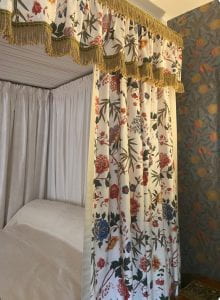Indian textiles have been used as the inspiration for many textiles around the world. A unique method of dying fabrics called block printing was used to dye intricate and fanciful designs on woven cotton fabric. 19th century Great Britain highly valued these Indian textiles as trophies of the British Empire. The textiles were a blueprint for British manufacturers and loved by British consumers.
In modern time, ‘chintz’ is the word used to describe all floral fabrics. The word is derived from the Hindi word ‘chint’ or ‘chitta’, which means spotted or variegated. The designs were hand drawn with a bamboo pen called a kalam. Then through the technical process of mordant and resist dyeing, the Indians would achieve bright, long-lasting colors. The Indians figured out how to add catalysts by adding acid solid or mud containing iron to the dyes they made out of flowers, fruits, barks, and roots. Figuring out the science behind this allowed the Indians to build a complex and diverse color palette of dyes.
The British public was initially exposed to the brightly dyed fabrics in the British sections of international exhibits, where the Indian textiles often outshone their domestic manufacture. People would by the Indian textiles from the exhibitions or from auctions after the exhibitions. Additionally, many entrepreneurs would import them to Britain to sell. Members of the British royal family also increased the status of these fabrics amongst the British population. The royals wore the bright fabrics on state occasions and less formal events. One royal, Queen Mary, used calicoes to decorate a bedroom. When word got out about this, the use of chintz on wall hangings, floors, and furniture became popularized and more widespread.
In Great Britain, many people South Asian textiles and designs to be part of British traditions, displaying them in British Museums. A popular British artist who utilized such designs was William Morris. One of Morris’ first designs for his company, Morris and Co was a trellis (lattice), a feature taken from Mughal architecture. Morris’ designs were heavily influenced by the styles of South Asia, but he never actually visited the region himself. He understood South Asia through interpreting objects and the works and writings of other white men. Textiles created using Indian techniques are displayed all over his summer home, Kelmscott Manor.
Today, floral fabrics like this can be found in many places in the UK and are considered part of British culture. One such place that has many of these fabrics on display is the heritage home, Kelmscott Manor. Although, Kelmscott manor has many traditionally British textiles that use embroidery to achieve their bright designs, it also has many Indian block printing designs on many of the curtains. Above, is a picture of the iconic floral printing motif on a bed curtain in Kelmscott Manor. These well-preserved artifacts show insight into the past and how important Indian textiles were for British décor. Even today. Modern printing has been impacted by these techniques and styles.


